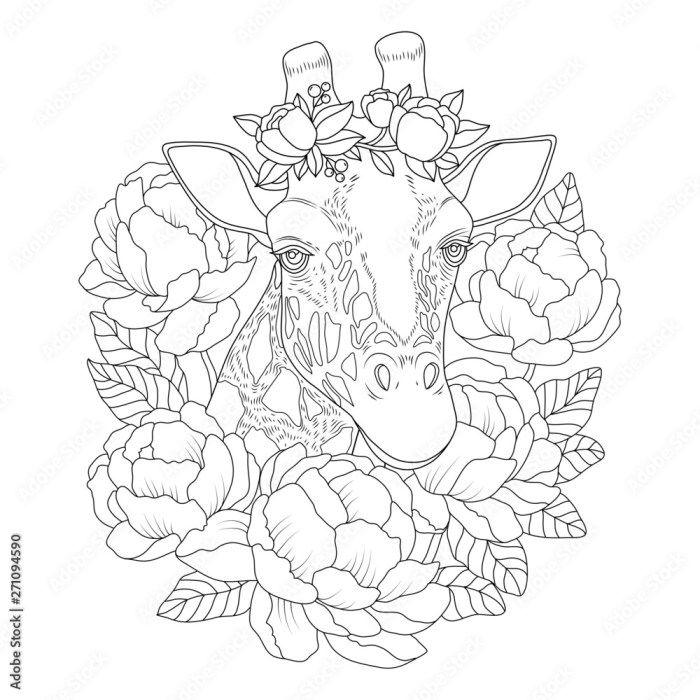Target Audience Identification

Floral animal coloring pages appeal to a broad demographic, but a focused understanding of the target audience is crucial for effective marketing and product development. This involves identifying specific age ranges, pinpointing user characteristics, and determining the most effective communication channels. Let’s delve into each aspect.
The primary appeal of these coloring pages lies in their combination of cute animals and vibrant floral designs. This naturally attracts a younger audience, but the therapeutic benefits of coloring extend to adults as well.
Age Ranges
The ideal age range for floral animal coloring pages spans a considerable spectrum. Children aged 3 to 8 years old will find the simple designs easy to color, fostering creativity and fine motor skill development. Older children, from ages 9 to 12, might prefer more intricate designs offering a greater challenge and artistic expression. Furthermore, adults, particularly those interested in mindfulness and stress reduction, also constitute a significant portion of the target audience.
The calming nature of coloring, combined with the appealing imagery, makes these pages attractive for relaxation and creative self-expression across all age groups.
User Characteristics and Interests
The ideal user of floral animal coloring pages exhibits several key characteristics. Children, for instance, are likely to be drawn to bright colors, simple designs, and recognizable animals. They might also enjoy coloring as part of a wider range of creative activities, such as drawing, painting, or crafting. Adults, on the other hand, may be drawn to more sophisticated designs, perhaps with a preference for specific animal types or floral patterns.
Their interest in coloring might stem from a desire for relaxation, stress relief, or a creative outlet outside of their daily routines. Many adult users may also have hobbies that overlap with nature, art, or crafting. They might collect botanical prints, enjoy gardening, or engage in other creative pursuits that complement the themes of the coloring pages.
Marketing Channels
Reaching the target audience requires a multi-pronged marketing strategy. Online platforms are essential. This includes creating listings on sites like Etsy or Amazon Handmade for direct sales. Social media marketing, particularly on platforms like Instagram and Pinterest, allows for visually appealing content showcasing the coloring pages and engaging with potential customers. Collaborations with parenting blogs, craft websites, or mindfulness influencers can extend reach and build credibility.
Furthermore, partnerships with educational institutions or children’s activity centers could provide avenues for distribution and promotion. Offline marketing might include participation in craft fairs or local markets, providing opportunities for direct engagement with potential customers. Finally, targeted advertising on relevant websites and social media platforms ensures that marketing efforts reach the specific demographics most likely to be interested in floral animal coloring pages.
Illustrative Style Considerations: Floral Animal Coloring Pages

Choosing the right illustrative style for floral animal coloring pages is crucial for attracting the target audience and ensuring the pages are both engaging and enjoyable to color. The style directly impacts the overall aesthetic and the coloring experience, influencing everything from the complexity of the designs to the level of detail required. We’ll explore three distinct styles to illustrate the diverse options available.
Comparison of Cartoon, Realistic, and Whimsical Styles
Three prominent illustrative styles readily lend themselves to floral animal coloring pages: cartoon, realistic, and whimsical. Each offers a unique aesthetic and appeals to different preferences. Cartoon styles prioritize simplicity and exaggeration, often featuring bold Artikels and simplified forms. Realistic styles aim for accuracy and detail, reflecting the true appearance of animals and flowers. Whimsical styles blend fantasy and reality, creating imaginative and often playful designs.
The choice among these depends largely on the intended age range and the desired overall mood of the coloring pages.
Line Weights and Textures in Different Styles
Line weight and texture play a significant role in defining the chosen illustrative style. Cartoon styles typically employ bold, consistent line weights, creating clear, easily identifiable shapes. Think of the classic bold lines used in children’s animation. Textures are often minimal, with solid fills or simple hatching for shading. Realistic styles, in contrast, utilize varied line weights to create depth and dimension.
Thinner lines might define finer details like fur or petals, while thicker lines delineate the main forms. Textures in realistic styles can be complex, incorporating stippling, cross-hatching, and other techniques to mimic the natural textures of fur, feathers, or petals. Whimsical styles allow for greater flexibility. Line weights can vary widely, creating a sense of spontaneity and playfulness.
Textures can be equally diverse, ranging from simple patterns to intricate, almost decorative designs, reflecting the imaginative nature of the style. For example, a whimsical fox might have fur textured with swirling patterns or a flower might have petals decorated with tiny hearts.
Impact of Style on Appeal and Target Audience, Floral animal coloring pages
The chosen illustrative style directly impacts the overall appeal and suitability for different target audiences. Cartoon styles, with their simplicity and bold lines, are generally well-suited for younger children (preschool to early elementary). The easy-to-follow Artikels and minimal detail make them accessible and less frustrating for beginners. Realistic styles, with their detailed rendering, may appeal more to older children and adults who enjoy a challenge and appreciate the accuracy of representation.
These pages often offer a more sophisticated coloring experience. Whimsical styles, with their blend of fantasy and reality, can appeal to a broader age range. Their imaginative designs and playful elements make them engaging for both children and adults who enjoy a touch of magic and creativity in their coloring activities. A whimsical unicorn with rainbow mane and floral crown would be an example that appeals across age groups.
Floral animal coloring pages offer a delightful blend of nature’s beauty and adorable creatures. For a slightly different farm-themed activity, you might enjoy the charming illustrations in feeding farm animals coloring , before returning to the whimsical world of flowers and fauna in your floral animal designs. The delicate details of petals and leaves complement the furry friends perfectly.
